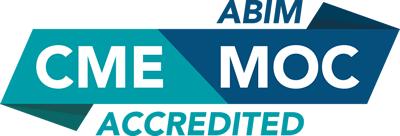
COURSE CREDITS & HOURS
14 AMA PRA Category 1 Credits™14 ACPE Credits
14.0 Contact Hours
14 (part II) MOC points in medical knowledge in the American Board of Internal Medicine's (ABIM) Maintenance of Certification (MOC) program
COURSE FEES
TARGET AUDIENCE
PROGRAM PURPOSE
- Osteoporosis
- Evaluate screening recommendations and apply them to everyday practice
- Utilize therapies that include bisphosphonates, PTH and inhibitors of the RANK/RANKL/OPG system
- Review the current controversies and clinical studies regarding Vitamin D
- Better advise patients on calcium supplementation
- MCI and Alzheimer's Disease
- Define Mild Cognitive Impairment in both amnestic and non-amnestic disease states
- Understand the potential implications of early diagnosis of dementia for patient care outcomes
- Describe the clinical manifestations of Alzheimer's disease
- Evaluate patients for symptoms of cognitive and functional loss
- Apply appropriate drug and non-drug interventions for patients with dementia
- Counsel families and caregivers at all stages of disease
- To Sleep: Perchance to Dream
- Describe the age-related changes in sleep
- Evaluate the psychiatric, medical, and neurological causes of sleep problems
- Implement office-based and objective methods for evaluating sleep disordered breathing
- Intervene with appropriate treatments for complaints of insomnia including CBTI as first line guideline directed care
- Management of Constipation
- Understand the common barriers that hinder the optimal management of chronic constipation in health care settings
- Define primary as well as secondary causes of hypertension in the older adult
- Provide a rational strategy to manage constipation based on current best evidence of the drug classes currently available
- Where Pain Management Meets Addiction Medicine
- Understand the pathogenesis of pain
- Apply recent guidelines in pain management including calculations for Morphine Milligram Equivalent Units
- Choose appropriate drug therapy and multimodal interventions for the relief of pain
- Consider the metabolic breakdown of different narcotics and their contribution to serotonin syndrome
- Employ newer tools to determine the potential for opioid dependence
- Pulmonary Disease in the Elderly
- Evaluate current trends in pulmonary disease in the elderly
- Review current immunization guidelines and supportive therapy
- Include new therapies like LAMA/LABA combination inhalers and roflumilast in the management of COPD
- Implement the appropriate use of nebulizers, MDIs and oxygen
- Apply guideline directed care to patients with COPD
- Nutritional Supplements: When East meets West
- Understand that adequate nutrition is a prerequisite for the maintenance of good health and optimum efficiency
- Find the on-line resources that provide the best evidence in support of dietary and nutritional supplements
- Identify targeted supplements for heart disease, vision, depression/mood, and urologic disorders
- Council patients on the risks of certain therapies in the presence of other disease
- Improve your working knowledge of the Mediterranean diet
- Errors in Medicine That Can Help You
- Discover and define Type 1 and Type 2 critical thinking
- Recognize and categorize the most common diagnostic errors and apply this knowledge to actual cases where errors occurred
- Update on the Treatment of Pneumonia and Bronchitis
- Identify the different organisms and antibiotics used for community acquired pneumonia (CAP), health care associated pneumonia (HCAP), and hospital acquired pneumonia (HAP).
- Know the most recent ATS/IDSA guidelines from 2019.
- Be able to apply and compute scoring systems used to determine location of treatment
- Be able to describe how unusual cases of pneumonia are treated differently.
- Update on the Diagnosis, Treatment and Management of Influenza
- Be able to describe the pathophysiology of influenza infections and why this virus can be so severe.
- Describe the diagnostic criteria for suspecting influenza and understand the accuracy of rapid swabs
- Differentiate which patients may be candidates for anti-viral medications for influenza.
- Know recent flu season data and also the impact of COVID-19.
- Skin and Soft Tissue Infections
- Rapidly recognize various skin and soft tissue infections.
- Describe the criteria and the diagnostic work up of severe soft tissue infections.
- Differentiate when surgery is needed for severe infections.
- The Impact of Patient Satisfaction on my Patients and My Practice
- Identify the financial impact of patient satisfaction on hospitals
- Be able to illustrate simple skills to improve scores.
- Be able to apply service recovery skills to patients.
- Case Studies of Unusual Infections
- Recognize and identify unusual infections.
- Be able to apply diagnostic and treatment strategies to manage these infections?
- Chief Complaint of Chest Pain, so Now How Do I Work It Up
- Be able to describe the criteria and scoring systems used to clinically rule out for CAD or PE.
- Apply the diagnostic criteria rule out emergency causes of chest pain and know the evidence based ways to work up these chest pain diagnoses.

















































